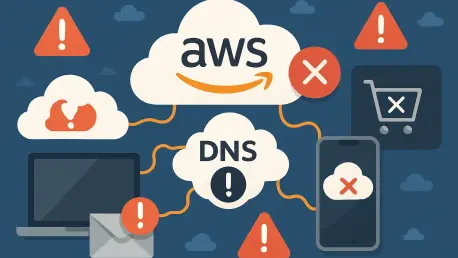In an era where digital infrastructure underpins nearly every facet of modern business, a single glitch in a major cloud provider’s system can send shockwaves across industries worldwide, exposing the fragility of interconnected ecosystems. On October 20, a critical DNS outage in Amazon Web Services (AWS), specifically affecting the DynamoDB API in the US-EAST-1 region, disrupted operations for countless companies and users. This incident serves as a stark reminder of how reliant global economies have become on cloud services for everything from payment processing to design tools and even fast-food apps. With AWS holding a commanding share of the cloud market, the event raises pressing questions about reliability, redundancy, and the future of digital infrastructure.
The cloud computing industry, led by giants like AWS, Microsoft Azure, and Google Cloud, has transformed how businesses operate, offering scalability and efficiency previously unimaginable. As organizations increasingly migrate critical operations to the cloud, the stakes for uninterrupted service have never been higher. This report delves into the specifics of the AWS outage, its widespread impact, the vulnerabilities it exposed, and the broader implications for cloud-dependent industries navigating an ever-evolving technological landscape.
Understanding the AWS Ecosystem and Its Global Reach
Amazon Web Services stands as a cornerstone of the global digital economy, providing cloud computing solutions to millions of businesses, from startups to Fortune 500 giants. As a leading provider, AWS offers a vast suite of services, including computing power, storage, and databases, powering critical applications across diverse sectors such as finance, healthcare, and entertainment. Its infrastructure supports an estimated one-third of the cloud market, making it an indispensable player in the industry.
Key services like DynamoDB, a high-performance database, Identity and Access Management (IAM) for security, and DynamoDB Global Tables for cross-region data replication highlight the interconnected nature of AWS offerings. Many of these services rely heavily on major hubs like US-EAST-1, a primary region for countless operations. The seamless integration of these tools enables businesses to scale rapidly, but it also means that a disruption in one area can ripple across the entire ecosystem.
AWS’s dominance is evident in its client roster, which includes major corporations like Netflix, Airbnb, and government entities worldwide. This extensive dependency underscores the scale of impact when outages occur, as businesses of all sizes rely on AWS for mission-critical functions. The outage on October 20 demonstrated just how deeply embedded AWS is in the fabric of global operations, amplifying the urgency for robust contingency measures.
Details of the AWS DNS Outage on October 20
Timeline and Initial Impact of the Incident
Shortly after midnight Pacific Time on October 20, AWS detected increased error rates and latencies affecting the DynamoDB API endpoint in the US-EAST-1 region. This initial disruption, though seemingly isolated, quickly escalated as dependent services began to falter. By 12:11 a.m., AWS issued a public report acknowledging the issue, noting that multiple services in the region were experiencing broader impacts beyond just the database functionality.
Within an hour of the first alert, the root cause was traced to a DNS resolution issue specific to the DynamoDB endpoint, a problem that hindered proper routing of requests. The cascading effects became evident as businesses relying on real-time data processing faced immediate operational challenges. This timeline illustrates the speed at which a localized glitch can impair a wide array of interconnected systems, leaving customers scrambling for solutions.
Scope of Disruption Across Regions and Services
Although the issue originated in US-EAST-1, its repercussions were felt far beyond the US East Coast, affecting global services such as IAM updates and DynamoDB Global Tables. These services, critical for user authentication and data synchronization across regions, rely on the stability of primary endpoints in major hubs. The outage revealed how a single regional failure can disrupt worldwide operations, even for clients operating in entirely different geographies.
Prominent companies bore the brunt of this disruption, with AI search platform Perplexity directly attributing its service interruption to AWS operational challenges. Similarly, design tool Canva reported significant issues with its underlying cloud provider during the same window, while Downdetector data suggested potential links to outages at Venmo, Roku, Lyft, Zoom, and the McDonald’s app. These examples highlight the diverse range of industries impacted, from tech and finance to consumer services, painting a picture of widespread dependency on AWS infrastructure.
Challenges Exposed by the DNS Outage
The October 20 incident laid bare the inherent vulnerabilities within cloud infrastructure, particularly the risk of single points of failure like DNS resolution issues. When a critical component such as DNS falters, it can sever access to essential services, halting operations for businesses that rely on real-time connectivity. This outage underscored the fragility of systems that, while designed for scalability, can collapse under the weight of a singular flaw.
Comparisons to past disruptions at other major providers, such as Microsoft Azure and IBM Cloud, reveal a recurring pattern of regional issues triggering global consequences. These incidents collectively point to an industry-wide challenge: the concentration of critical services in centralized regions increases efficiency but also heightens risk. The AWS event serves as a case study in how interconnected dependencies amplify the impact of localized failures.
Over-reliance on specific cloud regions poses a significant hurdle for global operations, as demonstrated by the cascading effects of this outage. Businesses often design systems assuming constant availability, leaving little room for error when infrastructure stumbles. This incident prompts a reevaluation of architectural choices, pushing the industry to confront the delicate balance between optimization and resilience in cloud environments.
AWS’s Response and Industry Implications
AWS moved quickly to address the DNS issue, implementing initial mitigations by 2:27 a.m. Pacific Time, approximately two hours after the problem was first reported. Customers were advised to retry failed requests, with the company acknowledging that lingering backlogs might cause additional latency. This interim guidance aimed to minimize disruption while engineers worked toward a comprehensive resolution.
By 3:11 a.m., AWS confirmed that global services dependent on US-EAST-1 had fully recovered, though updates were promised as more details emerged. While the rapid response mitigated further damage, the incident left a lasting impression on affected users, with service interruptions and delays impacting productivity. The effectiveness of AWS’s actions, though commendable, could not fully erase the operational setbacks experienced by clients.
The broader implications of this outage extend to cloud reliability and customer trust, raising questions about the adequacy of current failover mechanisms. Businesses may now reassess their dependency on single providers or regions, while AWS and its peers face pressure to enhance transparency and infrastructure robustness. This event could serve as a catalyst for industry-wide discussions on building more resilient cloud architectures to safeguard against similar disruptions.
Future of Cloud Infrastructure: Lessons and Innovations
Preventing similar outages requires a multifaceted approach, starting with diversified infrastructure to reduce reliance on single regions or endpoints. Implementing robust redundancy across multiple zones can help absorb the impact of localized failures, ensuring continuity of service. Additionally, enhanced DNS failover systems could provide a critical safety net, rerouting traffic seamlessly during disruptions.
Emerging trends in cloud resilience, such as multi-cloud strategies, offer a promising path forward, allowing businesses to distribute workloads across providers like AWS, Azure, and Google Cloud. Decentralized architectures also gain traction as a means to mitigate risks associated with centralized hubs. These approaches, while complex to implement, reflect a growing recognition of the need for flexibility in digital operations.
Innovation and industry collaboration will play a pivotal role in addressing systemic vulnerabilities, with cloud providers and businesses working together to establish best practices. Investments in advanced monitoring tools and predictive analytics could preempt potential issues, while shared standards for redundancy might elevate overall stability. As cloud dependency deepens, such cooperative efforts are essential to fortify the backbone of the digital economy.
Conclusion: Reflecting on a Wake-Up Call
The AWS DNS outage on October 20 served as a critical wake-up call for industries tethered to cloud infrastructure, exposing the fragility beneath the promise of scalability. Businesses impacted by the disruption faced immediate operational challenges, while the incident sparked broader concerns about the reliability of centralized systems. The rapid resolution by AWS mitigated some damage, but the event left an indelible mark on customer perceptions of cloud stability.
Moving forward, actionable steps emerged as vital considerations, including the adoption of multi-cloud environments to diversify risk and the prioritization of redundancy in system design. Cloud providers, in turn, faced heightened expectations to invest in failover mechanisms and transparent communication during crises. These strategies aimed to rebuild trust and ensure continuity in an increasingly digital landscape.
Looking ahead, the focus shifted toward fostering a collaborative ecosystem where shared innovations could address systemic weaknesses. Encouraging dialogue between providers and clients promised to yield solutions tailored to evolving needs. Ultimately, this outage highlighted the imperative to balance the benefits of cloud technology with proactive measures to safeguard against future disruptions.









